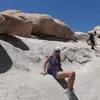You know that day-after-a-hard-workout feeling: your legs are aching, it hurts to laugh and sitting down is a super-human feat? This is called delayed onset muscle soreness—also known asDOMS. This differs from acute soreness, a feeling that develops during the activity itself.
This post-workout feeling can happen to even the fittest athletes. While it's relatively harmless, the swelling and tenderness can cause negative effects such as exercise burnout or injuries.
Fitness Events Near You
However, DOMS doesn't need to be a regular part of your exercise routine. Learn how to prevent DOMS from happening and discover how to mend your muscles if it does happen.
More: 5 Ways to Ease Sore Muscles
The Important Details
DOMS begins to develop 12 to 24 hours after your workout and reaches its peak between 24 and 72 hours later. Fitness professionals used to believe that this pain came from lactic acid buildup. However, studies have recently found that it's actually the result of microscopic damage to the muscle fibers that are involved in your workout, according to Delayed Onset Muscle Soreness from the American College of Sports Medicine.
Because microscopic damage occurs during the eccentric movement—when your muscle lengthens while force is applied—nearly any exercise activity can give you DOMS, including cardio and strength training. So, pretty much everyone who works out is susceptible to it.
More: 9 Running Injury Prevention Tips
Is it a Bad Thing?
While DOMS doesn't cause lasting damage, most health professionals still consider it a negative side effect. Excessive post-workout pain may mean that you're progressing too quickly in your program, which can cause more severe injuries.
DOMS can also become more dangerous if muscles are not given the necessary time to recover—24 to 72 hours. "DOMS can affect athletic performance by causing a reduction in joint range of motion, shock attenuation and peak torque," according to a study by the School of Community Health and Sports Studies at Auckland University of Technology in New Zealand. When these symptoms are still present, stronger muscles will compensate, which can lead to imbalances.
On the other hand, this extreme soreness can hinder you from working out altogether. This may throw your program off track, which ultimately delays progress.



